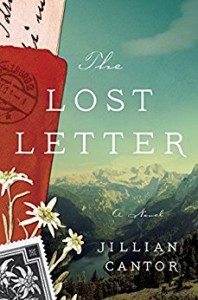The Lilith Blog 1 of 2
August 9, 2017 by Patricia Grossman
Q&A with Author of “The Lost Letter”
 Jillian Cantor’s new novel, The Lost Letter, alternates between two very different protagonists and settings. In 1938 Austria, young Kristoff is apprenticed to a master stamp engraver, while in Los Angeles in 1989 a journalist, Katie Nelson, is in the process of getting a divorce and working out new ways of relating to her father, who has Alzheimer’s and now lives at The Willows.
Jillian Cantor’s new novel, The Lost Letter, alternates between two very different protagonists and settings. In 1938 Austria, young Kristoff is apprenticed to a master stamp engraver, while in Los Angeles in 1989 a journalist, Katie Nelson, is in the process of getting a divorce and working out new ways of relating to her father, who has Alzheimer’s and now lives at The Willows.
As radically different as these characters’ experiences are on the surface, the novel slowly discloses that they are in fact inexorably linked.
Q. Your last novel, The Hours Count, featured Julius and Ethel Rosenberg. Did you encounter historical models for your characters as part in your research for The Lost Letter?
Kristoff and the Fabers are completely fictional, but I did find stories about real engravers in Europe who came to work with the resistance and forge papers, as Kristoff eventually does. I also found different real ways stamps were used in the resistance throughout the war. For example, the British special ops forged stamps by replacing Hitler’s head with Himmler’s, hoping to cause infighting in the regime, but then they put them into circulation and no one noticed! The stamps and resistance efforts in my novel are fiction, but it did all start for me with the idea that real stamps were used in the real resistance.
Q. Stamps of a certain time and place serve beautifully to pull the various threads of The Lost Letter together. Were you certain from the beginning of the novel that you wanted to use stamps—and one particular stamp—as a pivot for your story?
The idea for the novel started with stamps, so I was certain about that much from the beginning. I was chatting with my agent one day about what I was going to write next, and she asked me if I’d ever thought about the people who illustrate postage stamps. (I hadn’t before then!) I began to do a little research about stamp engravers, stamps in WWII, and stamp collecting, and the story blossomed from there. The idea that it would be about one particular stamp came a bit later, as I was writing the first draft and plotting out the novel.
Q. In what ways does Katie’s experience tracking down the story of the stamp change who she is in the story?
Katie was raised Jewish but married a Christian man, whom she’s in the process of divorcing as the story opens. She’s also dealing with her father losing his memory. So, she’s floundering a bit in her identity. Discovering the history of the stamp makes her rethink what it means to be a woman and a Jew living in her own time. In the beginning of the novel she’s lost touch with her religion, but by the end she rethinks its importance in her life. Also, the more she learns about Kristoff and Elena, the more she understands how lucky she is to have been born where and when she was, and that definitely affects how she views her world and her own choices.
Q. There are two romances in The Lost Letter, each blooming in a different era. How did these two settings affect how you portrayed each romance?
Part of what I wanted to explore when I was writing was how ordinary people live their lives in extraordinary circumstances. In the 1938 story, there’s the Nazi occupation of Austria, Kristallnacht, and the impending war, In the 1989 story, the characters live in America and are free to make their own choices, but they’re deeply affected by personal tragedy.
In both settings I was trying to explore the question of how you can fall in love amid chaos, uncertainty and tragedy, both large and overwhelming and small and personal.
Q. Katie relentlessly pursues the origin of a stamp in her father’s collection right as she is losing him to Alzheimer’s. What did she hope to gain in her relationship with her father by solving the mystery of this stamp?
I lost my own grandmother to Alzheimer’s a few years before I wrote this book, so I was really interested in writing a novel about memory and loss and the things that remain even as people we love begin to lose everything they remember. In the novel, Katie never understood her father’s obsession with collecting stamps as she was growing up, but he always told her he was looking for a “gem.” So she equates finding his “gem” with understanding him, in a way. And this stamp is also a tangible piece of his life, his interests, even as so much of him is disappearing in front of her.
Q. The idea of a Jew trying to resist the Nazis, as Frederick Faber’s daughter Elena does, is painful to read about. Did writing about characters living under—and resisting—Nazi oppression affect you personally?
It was actually both painful and empowering to write them. Elena is so tough, and she refuses to stop fighting no matter how dangerous it is for her. It felt really great to write a character who is such a fighter, who keeps on resisting no matter what. But also it was painful to write.
The views and opinions expressed in this article are the author’s own and do not necessarily reflect those of Lilith Magazine.
 Please wait...
Please wait...